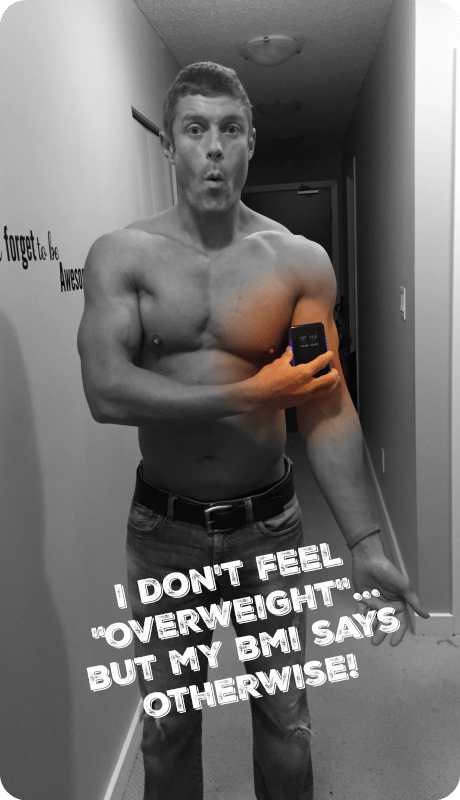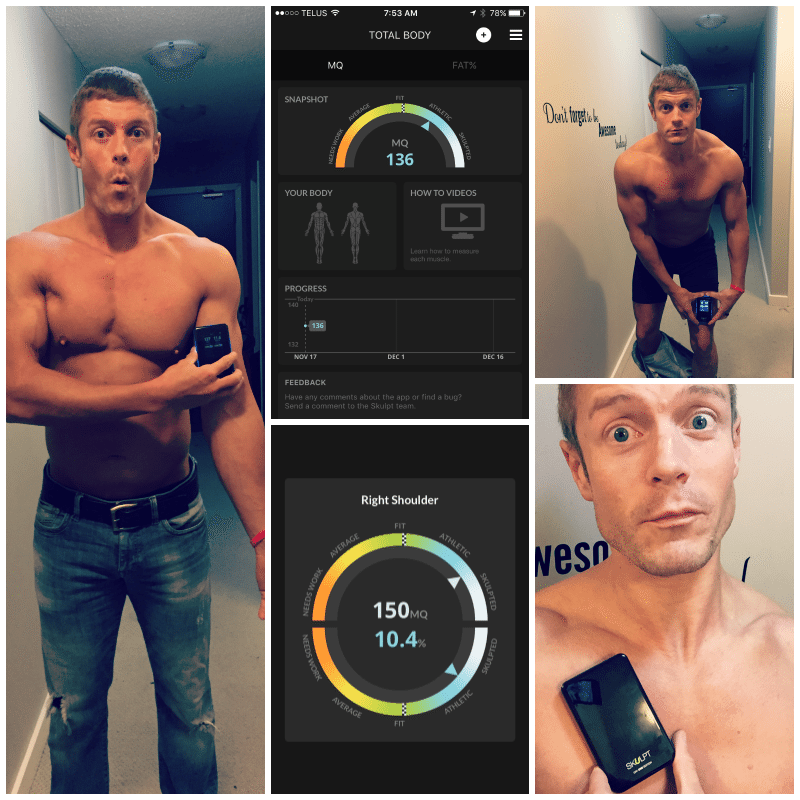WTF: What the Fat about Body Composition and BMI (and how to measure it)

 There’s more to measuring fitness than gender, height and weight.
Being 'fit', no matter where you're at in life, can be based on many more accurate methods.
There’s more to measuring fitness than gender, height and weight.
Being 'fit', no matter where you're at in life, can be based on many more accurate methods.For years I have told people that the BMI is not an accurate indicator of health and fitness .
As of late, I’ve seen some reputable sources quote the Body Mass Index as a way to gauge your health and fitness levels which I find laughable for several reasons. Most blatantly obvious is the fact that I’m considered borderline obese based on my rating of 28.6 on the BMI chart.
Below is my absurd BMI rating! Do you know what your BMI score is?
This leads to the question...
[caption id="attachment_20694" align="aligncenter" width="655"]
 My BMI results
-- Guess I'm borderline obese?[/caption]
My BMI results
-- Guess I'm borderline obese?[/caption]WTF: What the Fat about Body Composition and how do I measure it?
Before we start talking about body composition, I want to discuss the elephant in the room -- " Weight Loss". After 20 years in the fitness industry I've become somewhat jaded to the term based on the scale obsession it creates within people. "Weight Loss" should never be confused with "Fat loss", yet most people look to the scale and become upset if the number doesn't continue to go down, down, and down. I have most definitely been guilty of obsessing about the number on the scale in the past.
But what's the inherent problem with obsessing about body weight on the scale? Well, for starters, a pound of fat and a pound of muscle might weigh the same, but they are very, very different.
[caption id="attachment_20715" align="aligncenter" width="612"]
 Muscle vs Fat: When a Pound is Not a Pound [Photo Credit: Funeral For My Fat
][/caption]For one, the muscle tissue actually serves a very important function. It's the only tissue in the body that can contract and in turn move parts of the body. Also, without it, we wouldn't be able to support good posture or body positioning. Based on this it requires energy (aka calories) to function optimally.
Muscle vs Fat: When a Pound is Not a Pound [Photo Credit: Funeral For My Fat
][/caption]For one, the muscle tissue actually serves a very important function. It's the only tissue in the body that can contract and in turn move parts of the body. Also, without it, we wouldn't be able to support good posture or body positioning. Based on this it requires energy (aka calories) to function optimally.Whereas, fat tissue on the other hand is needed by the body for a slew of functions like temperature regulation, absorbing shocks, certain reproductive roles (in particular in women), regulation of many nutrients/vitamins as well assists in maintaining the health of skin, nails and hair.
I also like to think of fat as stored "potential energy"... stored away for a rainy day or maybe a famine? Well, the problem is with most 1st world countries, we see the population with an excess of "potential" energy stored and it seems we never dip into it, so as a nation we continue to get fatter and fatter.
So, when we start talking about "weight loss", we really need to be saying "fat loss". Remember that a pound of fat takes up as much as 4 times the space on our bodies as a pound of muscle. I don't know about you, but I'd rather be 200 lbs at 10% body fat then 200 lbs at 25% body fat - the difference would be about 10 inches on the waist! (and I know this for a FACT! See pictures below of me before I started CrossFit and the Paleo/Zone diet back in 2007/2008)
[caption id="attachment_20736" align="aligncenter" width="700"]
 Have a read of this article to learn how my body has changed based on diet and exercise... body composition people - not a number on the scale.[/caption]
Have a read of this article to learn how my body has changed based on diet and exercise... body composition people - not a number on the scale.[/caption]We've got plenty of energy to share with the world, so time to tap into it, go for a workout and sweat it out. After all, sweat is just FAT crying, right?
[tweet_box design="box_12"]I love going to the gym and getting a good sweat on... after all, it's just my fat crying![/tweet_box]
What's the best and most convenient way of testing body composition, body fat percentage and muscle quality?
I've tried a myriad of different systems for testing body fat - and I own most of them throughout my history in the industry. Whether a Tanita Body Fat Ironman scale to electronic and old-school "pincher-like" calipers, they've all been good at serving a process - testing body composition conveniently and accurately. That's why I was excited to be introduced to the Skulpt AIM a while ago and most recently to the newer (more affordable) version, the Chisel, which I will go on to tell you more about in the following sections.
The Skulpt fitness trackers provide the easiest, most exact and only way to measure your muscle quality (MQ) along with body fat composition, that I've found. (thumbs up!)
[caption id="attachment_20720" align="aligncenter" width="599"]
 Me and my Skulpt... body comp testing in less than 2 minutes![/caption]
Me and my Skulpt... body comp testing in less than 2 minutes![/caption]The old days of gauging your health based on your body mass index are no more! The Skulpt , in my opinion, uses technology which makes calipers, impedance scales, and most other body-comp tests irrelevant... and it fits in the palm of your hand.
[box type="info" align="aligncenter" class="" width=""]NOTE: Skulpt just announced the launch of its next generation product, the Chisel, available on Indiegogo today for only $99 .

It’s a leaner, lighter, more affordable tracker for measuring % body fat and muscle quality with gold-standard accuracy. Your results sync instantly on your smartphone app. Do yourself a favor, and get one today.[/box]
What are the Skulpt AIM and Chisel?
The Skulpt AIM and Chisel units (available for pre-order on Indiegogo) are about the size of your average smart phone. The AIM has a screen on one side and twelve metal bar sensors on the other. The Chisel is screenless, so you're ready to go once you've downloaded the software to your smart phone or computer. The trackers tell you which part of your body to put the sensors on. Spritz the area with water and lay the sensor flush against the skin. This is where the technology takes over.
[video width="360" height="648" webm="https://cdn.proshark.com/daimanuel/2015/03/new-ui-loop-3.webm" poster="https://cdn.proshark.com/daimanuel/2015/03/Skulpt-Me-Syncs-with-your-phone.png"][/video]
How does the Skulpt AIM & Chisel technology work?
The AIM and Chisel units use EIM technology ( Electrical Impedance Myography ). This was developed by the founders of Skulpt – Dr. Seward Rutkove (Neurologist at Harvard) and Dr. Jose Bohroquez (Electrical Engineer MIT). It was developed to track the muscle progress in patients that were suffering from various muscular disorders. Before EIM, there really was no way to see this muscle progress.

With both the Skulpt AIM and Chisel , the EIM technology does the work for you. Both units use 12 sensors on multiple frequencies to send a small current through the muscle. The current will flow differently through the muscles due to muscle fiber size and composition. Skulpt trackers evaluate the results and gives you the MQ of your muscles. Best of all, it is painless and takes only seconds.
[box type="warning" align="aligncenter" class="" width=""] As a quick cautionary note though – because the Skulpt fitness trackers use tiny electrical impulses, people with electrical devices implanted – like pacemakers – and pregnant women are not advised to use it. [/box]
How do I use the Skulpt Aim/Chisel to measure my body fat (BF) and muscle quality (MQ)?
The AIM and Chisel units will run through and tell you which muscles to test or you can choose the muscle. If you measure your biceps, triceps, abdominal region, and thighs, the units will give you your total body fat % and total MQ (Muscle Quality) score. An average MQ score is around 100. The higher the score, the better. (I've shared my results below)
[caption id="attachment_18264" align="aligncenter" width="623"]
 My results with the Skulpt AIM device
[/caption]
My results with the Skulpt AIM device
[/caption]The Skulpt AIM unit comes with a charging station, and will sync with select devices via Bluetooth. The unit will allow up to 6 different users programmed in at any given time, as well assigned a unique color so to differentiate the results. You can track your progress daily, monthly, and yearly using the color graphs and scales. Everything is extremely easy to read and understand.
6 Reasons Why the Skulpt AIM or Chisel is a must have
- Measure body fat and Muscle Quality (MQ) to help you get seriously fit and stay motivated
- There is real science behind how the Skulpt Aim works
- Skulpt Aim can actually separate out condition of muscle from amount of fat in seconds
- Differentiates high (lean) muscle quality versus low (fattier) muscle quality
- Measures Total Body MQ & Fat quickly so you can manage weight loss goals
- Measures 24 muscle groups individually, so you can fine-tune your workouts
For any serious athlete, this AIM unit is definitely worth every penny. Tracking muscular development and quality of muscle along with body fat percentage, this is key, but best of all you'll never use a pair of calipers again! Whether you're a competitive athlete or a weekend warrior, anyone who spends time to train their body will find this progressive piece of technology purely awesome!
[divider style="dashed" top="15" bottom="15"]
[toggle title="BMI: A Poor indicator of health and fitness" state="close"]
BMI: A Poor Predictor of Health, Fitness and Wellness
Below is an amazing article, written by Patrick Vuong, entitled " BMI: A poor predictor of health and fitness " as posted on the Fitness Town Blog.
As we move into the 21st century, and the health and fitness of Western populations and populations throughout the world are getting worse, it is important that fitness consultants, experts, and doctors are able to accurately measure the health of the uninformed public. An inaccurate measure of health could promote negative self-esteem among the healthy and can lead them to pursue unnecessary diets. On the other hand, those who are unhealthy may be mislead to think they are completely healthy.
The most popular method of determining health and obesity is the Body Mass Index (BMI) due to its simplicity and affordability. BMI measurement ranges are separated into categories of severely underweight, underweight, average, overweight and three classes of obesity. BMI is calculated by dividing your weight in kilograms by your height in meters.
The problem with the BMI method is its inaccuracy in assessing people with a lot of muscle mass or a large frame. The BMI method loses much of its validity because it does not take into account one’s body composition including proportions of fat, water, bone, etc. As more and more health professionals and clinicians are using this method to assess the health of populations and people, we ask ourselves: how did we end up with such a faulty statistic?
History of BMI
The formula first came up when Adolphe Quetelet published a study to define the “average man” in 1832. This study was not meant to determine obesity or obesity-related diseases. In his study, he found that a person’s weight varied not in direct proportion to a person’s height but the square of his height.
In the early 1900s, it was generally agreed by most medical professionals and organizations that people with too much adipose tissue (fat) were more likely to develop diabetes, hypertension, and other coronary heart diseases. Large scale studies were being carried out by health researchers and insurance companies throughout the century. It wasn’t until 1972 when Ancel Keys published his “Indices of Relative Weight and Obesity” to check which height to weight formula correlated best with body fat %, that he found out the best indictor came from Quetelet’s formula, which Keys renamed the “Body Mass Index.” However, Keys warned against using this formula for personal diagnoses as the equation ignores factors like gender, age, body composition and how BMI affects health.
Limitations
One major shortcoming of the BMI equation is that it is over-simplistic. The formula is derived from population studies and the majority of people today lead very sedentary lives. Therefore, BMI assumes a lower lean body mass and higher relative fat or adipose content for the average person. This error in calculation leads to an overestimation of adiposity in people with a greater lean (fat-free) mass like muscled athletes. Likewise, BMI calculations underestimates adiposity on people with lower lean body mass like the elderly.
A further shortcoming is related to aging. As one ages and gets shorter and their weight stays the same, their BMI will actually increase. The standard BMI chart does not apply to everyone. Separate BMI charts and standards are needed for special populations. The BMI classifications for a “healthy” person are different for children and people who live in different countries.
In an analysis of over 40 studies involving a sample size of over 250,000 people, it was found that those with a lower BMI (<20) showed a greater risk of death from cardiovascular disease than people who were classified as normal (BMI 20-24.9). People classified as “overweight” (BMI 25-29.9) had the lowest incidence of total mortality and cardiovascular mortality. This study concluded that BMI is a poor evaluator and predictor of cardiovascular mortality. Their findings show that BMI fails to differentiate between body fat and lean mass.
Conclusion
While the BMI may be an okay indicator for large populations in epidemiological studies, it should never be used to diagnose individuals. There are many better clinical applications that can be used to assess body composition and health. The waist to hip ratio, waist girth measurements, and body composition analysis using dual energy x-ray absorptiometry (DEXA) or other methods are far more accurate techniques to test a person’s health and fitness.
[/toggle]
[divider style="dashed" top="15" bottom="15"]
 And to be absolutely clear, this is my disclaimer: “Just so you know, I have been compensated to share my ideas on this topic. Sometimes it is in the form of products, or services or even money… But here’s the thing; I won’t share anything with you that I don’t fully support. It doesn't matter what it is, or how much they are willing to give me, if I don’t believe in it, It won’t be on my site. Seriously. You’ll just have to trust me on this.”
~ Moose
And to be absolutely clear, this is my disclaimer: “Just so you know, I have been compensated to share my ideas on this topic. Sometimes it is in the form of products, or services or even money… But here’s the thing; I won’t share anything with you that I don’t fully support. It doesn't matter what it is, or how much they are willing to give me, if I don’t believe in it, It won’t be on my site. Seriously. You’ll just have to trust me on this.”
~ Moose
[divider style="dashed" top="15" bottom="15"]




































































































